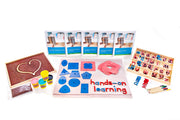“There must be provision for the child to have contact with nature, to understand and appreciate the order, the harmony and the beauty in nature… so that the child may better understand and participate in the marvelous things which civilization creates.”
Maria Montessori
How to Start Using a Phenology Wheel and Why You’d Want To!
A huge trend among homeschooling families is nature study. In an era where we are indoors more than ever before in human history, getting our kids (and ourselves) outside more often is a huge benefit. In addition to the popular nature journal, a phenology wheel can be an excellent addition to nature study for homeschoolers and parents alike.
Phenolo What?!?!
Phenology sounds like something you might see on a nameplate at a doctor's office. In reality, phenology is the study and observation of natural events and cycles. Phenology is a fantastic way to get more in touch with the tune of nature.
What is a Phenology Wheel?
A phenology wheel is simply a way to document your observations in one spot. It allows you to make note of your observations and keep an easy-to-use record of what you’ve seen. Phenology wheels help us to stop and reflect on something we might not otherwise notice. When we work on phenology wheel, we notice the changes in plants, trees, wildlife, weather, and ourselves in a way we never have before. The wheel enables our children to notice small details and to grasp the calendar in a new way.
Generally, people draw their observations and use the wheel as a visual guide and enhancement to their nature journal. However, if you’re not artistic (or have a student who does not like to draw) the wheel can be written on instead. The wheel itself is simply a circle broken up into equal sections. Traditionally, the wheel is made to reflect one year, so it is broken up into twelve sections. We will use this model as our example.
How Do I Get Started?
Making a phenology wheel is easy. It just requires a compass, protractor, pencil, ruler, and art supplies (alternatively, a large enough circular object to trace would work). You can make your own or use the template we’ve provided below get it here.
- Begin by making a large circle on the center of your paper
- Next, make a small circle within in- about a ¼-½ inch smaller than your first circle
- Next, make a small circle in the very middle of your larger circle- a couple of inches across is good
- Divide your two inner circles into even sections of 12 (this is a great math opportunity!)
- Don’t divide up that outer ring you created
- Time to label
- Around the outside ring, label your seasons (people often color coordinate this as well)
- The first “layer” gets the months of the year written at the top of each section
- Leave the inner ring blank for now
How to Use Your Phenology Wheel
Now that you have set up your wheel, how on earth do you put it to work? To a certain extent, this is totally up to you. The natural world, your current science study, and the interest of your homeschooler can be your guide. Pick two different things to study throughout the year, we provide some ideas below. Also, pick a day of the month to make your observations (it’s ok if you get off a day or two in either direction.)
You’ll head out on your designated day each month and make your notes and artwork to have a beautiful visual record at the end of the year. The outer wheel and inner wheel can be used to observe two different things, two different aspects of the same thing, or one for drawing and one for written notes. As the year progresses, you’ll begin observing more astutely and keenly what changes are happening right under your eyes that you might not have otherwise noticed.
If desired, spend time studying what you’re observing from books and documentaries as well. Perhaps you could visit a local expert or arrange a class at a nature center. You can even adapt the science portion of your homeschool curriculum to include information on what you’re documenting.
Here are a few ideas for observation:
-
Use the outer circle to observe an animal, and the inner a place in your yard
-
Observe your household pet’s fur and habit changes throughout the year
-
Make note of the changes sees in a tree and an area with wildflowers
-
Go to the beach at the low time and make note of the animals seen on the outer circle, and tide times on the inner
-
Use the wheel to document the height/weight of your student(s), and something they learned, a first, or something they loved each month
-
Observe the sky and stars
-
Make note of the fur on your favorite zoo animal and any other changes taken in their living environment
This method can also be used on a smaller scale. Perhaps set up a wheel for a month or two observation of the growth of your favorite garden vegetable! Or if you live somewhere with snow, observe the different types of snowflakes and the weather when they fall. This is also a popular way to observe the moon cycles each night over the course of a month.
As you can see, there are countless ways to incorporate this tool into your homeschool curriculum. The entire family can observe the same thing, or everyone can choose to study something different. Depending on the approach you take, you could be including, art, science, research, reading, and math with this beautiful project.






